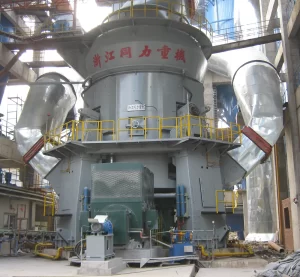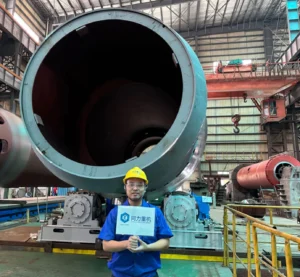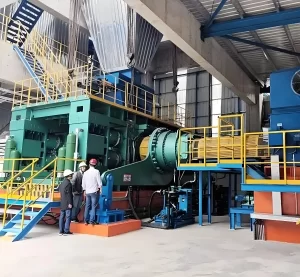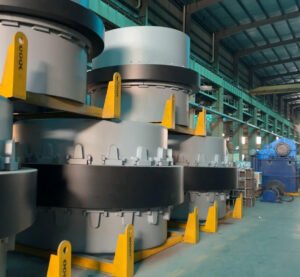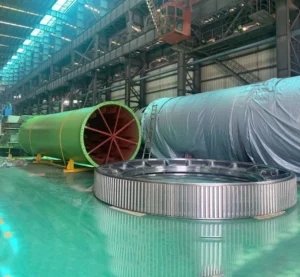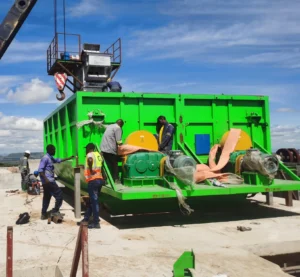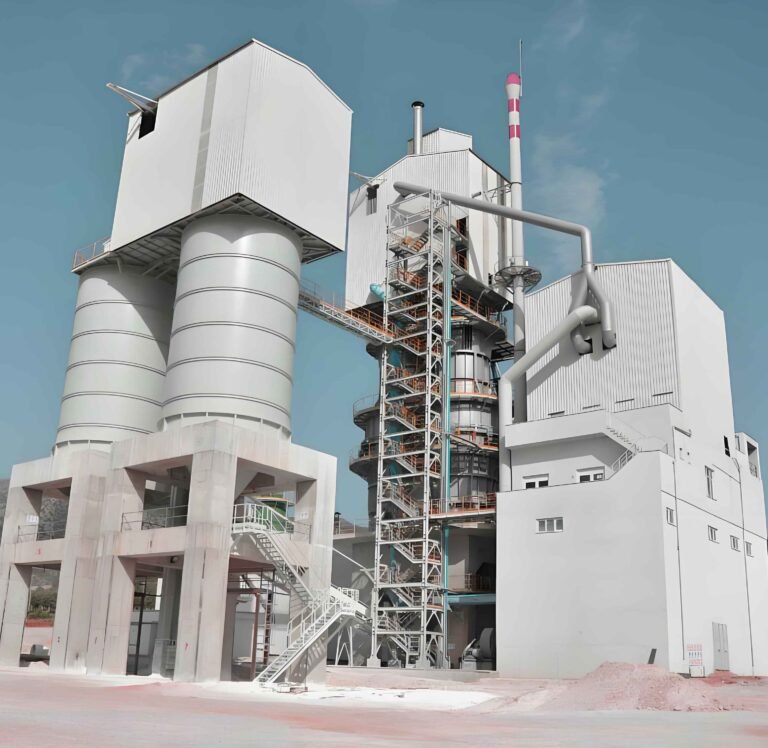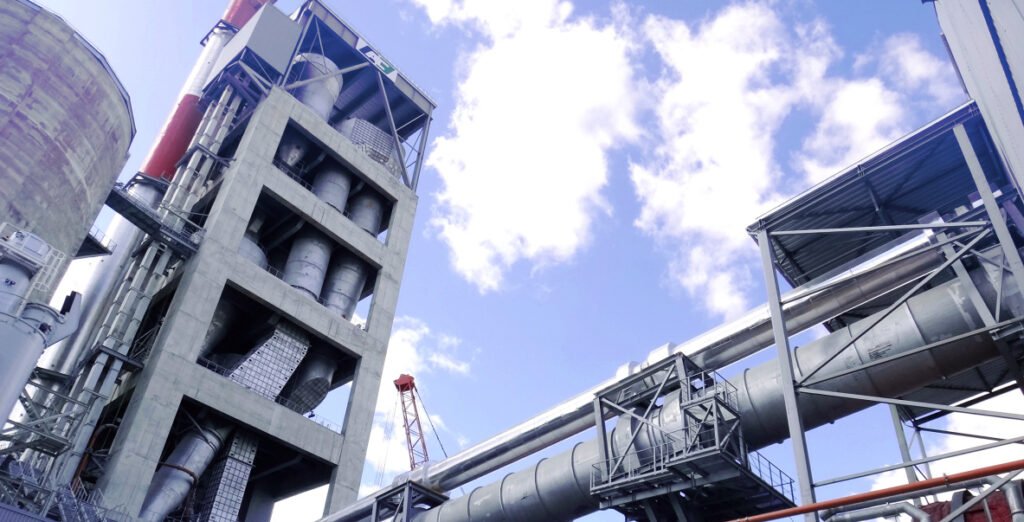
A 5 stage cyclone preheater in cement plant is the main gas-solid mixing unit of the cement raw meal pre-decomposition system, its main function is to use suspension preheating to preheat and partly decompose the cement raw mix. It makes full use of the high-temperature exhaust gas discharged from the kiln tail while replacing the material preheating process and partial calcium carbonate decomposition process in the kiln, making the limestone & gypsum powder fully in contact with the hot air thereby shorten the calcination time needed of the rotary kiln. The working principle of cyclone preheater is to feed raw materials such as limestone or fly ash into the preheater, and through the heat and mass transfer of high-temperature gas and raw materials, fully mix raw mix and hot air in the kiln. TONGLI cyclone pre-heater has the adventage of simple but compact structure, high efficiency and small space occupation.
Why cyclone preheater is used in cement industry?

- High efficiency pre-heating: 5-stage cyclone preheater is connected in series to fully preheat the raw material before entering the rotary kiln. The raw material can be preheated to above 800℃ therefore save energy.
- Energy saving: Since the raw material is fully preheated in the preheater, the heat required after entering the kiln is reduced, thereby reducing fuel consumption. At the same time, the 5-stage cyclone preheater can utilize the waste heat of the exhaust gas at the end of the kilntail, improving the thermal efficiency. Compared with other preheating methods, it can reduce heat consumption by about 20% - 30%.
- Increased production: The 5-stage cyclone preheater can quickly and evenly preheat the raw material to a higher temperature, speed up the calcination process in the kiln, and increase the output of the rotary kiln. Generally speaking, the dry process cement production line with a 5-stage cyclone preheater has a 30% higher output than the traditional production line.
- Stable product quality: The preheated raw material is more stable after entering the kiln, which can control the firing temperature and time of the clinker, making the mineral composition of the clinker more uniform, thereby improving the clinker quality.
- Environmental benefits: The cyclone preheater utilizes the high-temperature exhaust gas at the kiln tail, reducing exhaust gas emissions. It reduces fuel consumption and thus reduces the emission of greenhouse gases such as carbon dioxide.
How does a cement clinker pre-heater work?

The cement plant's 5-stage cyclone preheater is connected in series in multiple stages. The high-temperature exhaust gas discharged from the kiln tail and the fed raw material are combined in the cyclones of each stage by centrifugal force and airflow, so that the raw material can fully exchange convection and radiation heat with the hot air flow in a suspended state, achieving gradual preheating and temperature rise. The decomposition furnace is combined with the last stage to promote the pre-decomposition of the raw material. At the same time, each stage of the cyclone completes the efficient separation of the material and the airflow.
Cyclone pre-heater working principle in steps: detailed explanation
Step 1: Airflow and material entry:
The high-temperature exhaust gas discharged from the kiln tail enters the top cyclone of the 5-stage cyclone preheater, usually the C1 cyclone. At the same time, the raw material is fed from the upper part of the C1 cyclone, blown away by the high-speed rising hot airflow and brought into the cyclone.
Step 2: Airflow and material entry: Primary preheating:
In the C1 cyclone, the airflow carries the raw material particles to rotate. Under the action of centrifugal force, the raw material particles are thrown to the inner wall of the cyclone and slide down along the inner wall, while the airflow is discharged from the central tube of the cyclone and enters the next cyclone. In this process, the raw material particles are fully in contact with the high-temperature airflow, heat exchange is carried out, and the temperature is initially increased.
Step 3: Multi-stage series preheating:
The raw material and airflow preheated by the C1 cyclone enter the C2, C3, C4, and C5 cyclones in turn. In each cyclone, the raw material repeats the process of being blown away by the airflow, fully mixed with the hot airflow for heat exchange, and separated and falling under the action of centrifugal force. As the number of stages increases, the temperature of the raw material gradually increases, while the temperature of the airflow gradually decreases.
Step 4: Heat exchange:
In the cyclone preheater, heat exchange is mainly carried out in two ways. One is convection heat exchange, in which the high-temperature airflow directly contacts the raw material particles suspended in it and transfers heat to the raw material; the other is radiation heat exchange, in which the high-temperature airflow and high-temperature components such as the inner wall of the cyclone radiate heat to the raw material particles. Since the raw material is dispersed into extremely fine particles and is suspended in the cyclone, the contact area with the airflow is large, and the heat exchange efficiency is very high.
Step 5: Raw material pre-decomposition:
The last stage of the 5-stage cyclone preheater is the C5 cyclone. After the preheating of the previous stages, the temperature of the raw material is close to the temperature of carbonate decomposition. At this time, substances such as calcium carbonate in the raw material begin to decompose and generate calcium oxide and carbon dioxide. Since the airflow in the preheater contains a large amount of carbon dioxide, which will inhibit the decomposition reaction of calcium carbonate, a decomposition furnace is usually set at the outlet of the C5 cyclone. Fuel is introduced into the decomposition furnace to generate high temperature by burning the fuel, providing the required heat for the decomposition of calcium carbonate, while reducing the concentration of carbon dioxide in the airflow and promoting the pre-decomposition of raw materials.
Step 6: Separation of materials and airflow:
In each stage of the cyclone, when the airflow carries the raw material particles to rotate, due to the centrifugal force, the movement trajectory of the raw material particles will deviate toward the inner wall of the cyclone, and the airflow will be mainly discharged from the central tube of the cyclone. When the raw material particles reach the inner wall of the cyclone, they will slide down along the inner wall and finally enter the next stage of the cyclone or be discharged from the preheater, thus realizing the separation of materials and airflow. This separation method is highly efficient and can ensure that the raw material is fully preheated and pre-decomposed in the preheater, while also reducing the loss caused by the discharge of raw material with the airflow.
Thermal efficiency analysis of pre-heater cyclone:
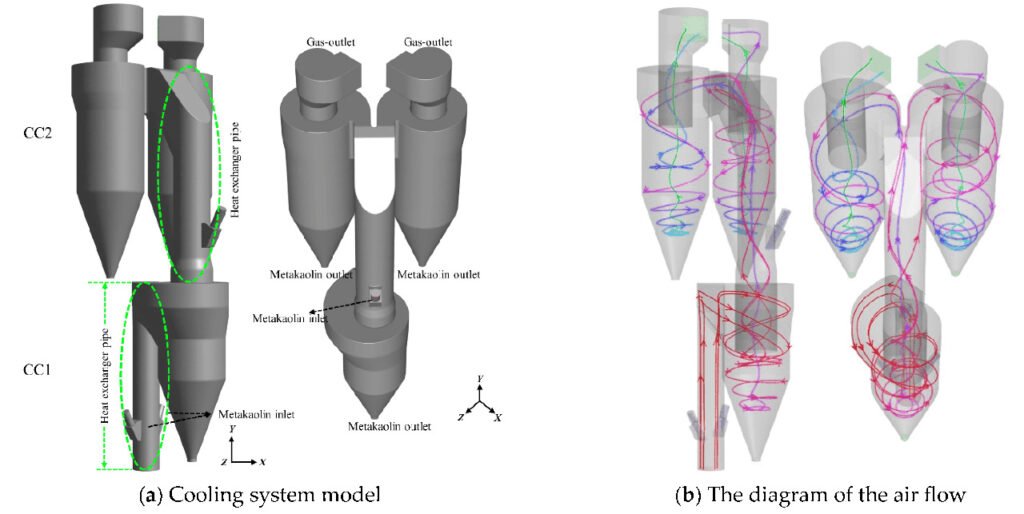
(I) Material powder suspension rate
The material powder suspension rate refers to the mass percentage of the feed material suspended into the cyclone separator, which is the basic factor affecting the thermal efficiency. When the powder material is fully and evenly dispersed and suspended in the airflow, more than 80% of the heat exchange can be completed instantly at the inlet pipe of the cyclone separator. Under normal working conditions, the ideal suspension rate needs to reach 90% or above. If the material particles are large, some materials cannot be suspended by the airflow after falling a certain distance. Once they leave the lower inner tube, the air volume drops sharply, and this part of the material cannot be effectively preheated, resulting in reduced thermal efficiency. The suspension rate can be effectively improved by measures such as placing the feed position close to the starting end of the air inlet pipe, controlling the air flow speed in the pipeline at 18-22m/s, and installing a paver at the feed port.
(II) Gas-solid phase separation efficiency
The gas-solid phase separation efficiency of a single-stage cyclone is usually in the range of 85%-95%. In a 5-stage cyclone preheater system, low gas-solid separation efficiency will significantly increase the dust concentration of the outlet exhaust gas, increase the burden on the subsequent dust collector, and reduce the thermal efficiency of each stage of heat exchange units. Studies have shown that the system thermal efficiency is positively correlated with the separation efficiency. When the separation efficiency of the first-stage cyclone separator is less than 60%, the thermal efficiency of the entire system changes significantly; after the separation efficiency is greater than 60%, the influence of each stage of cyclone separator on the system thermal efficiency tends to be stable. The separation efficiency can be improved by reducing the diameter of the cyclone separator (usually a 10% - 15% reduction in the single-stage diameter can increase the separation efficiency by 3% - 5%), using a rectangular air inlet and controlling the inlet wind speed at 16 - 22m/s, reducing the exhaust pipe diameter and increasing the insertion depth, and increasing the cyclone separator height (every increase of 1 - 2m, the separation efficiency increases by 2% - 3%).
(III) System solid-gas mass ratio (Z)
The system solid-gas mass ratio is the ratio of the mass of solid particles to the mass of gas particles in the preheater cyclone separator. Theoretical and practical data show that when Z <2, the gas-solid heat transfer efficiency increases exponentially with the increase of Z value; when 2 < Z < 3.6, the Z value has little effect on the heat transfer efficiency; when Z> 3.6, the heat transfer efficiency decreases. In actual production, the Z value is controlled within the range of 2 - 2.2 to achieve the best heat transfer efficiency, at which time the unit heat consumption can be reduced by 8% - 12%.
(IV) Air leakage
Air leakage includes internal leakage and external leakage. Internal leakage refers to the exhaust gas from the lower cyclone separator flowing back to the upper part through the loose baffle valve. When the internal leakage exceeds 2%, the separation efficiency begins to decrease. For every 1% increase in internal leakage, the system thermal efficiency decreases by 1.5% - 2%. External air leakage is the inflow of cold air from the atmosphere. For every 10% of cold air that leaks in, the temperature of the hot gas decreases by 8-12℃, the system solid-gas mass ratio decreases by 15%-20%, and the thermal efficiency decreases by 10%-15%. Only by strictly controlling the total air leakage rate below 5% can the efficient operation of the system be guaranteed.
What is the structure and component of a dry process cement cyclone pre-heater?
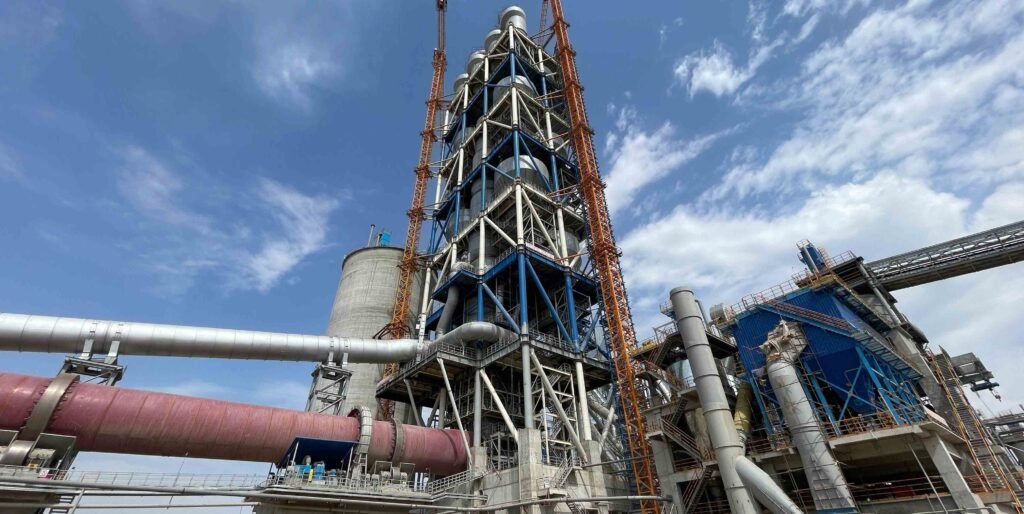
The 5-stage cyclone preheater is mainly composed of C1-C5 cyclones, feeding system, connecting pipes, decomposition furnace, spreading device, pushing device, hydraulic system, air lock valve and frame.
- Cyclone: The cyclone of Tongli 5-stage cyclone preheater is generally composed of five cyclones of C1-C5. Each cyclone includes structures such as air inlet, cylinder, cone, ash outlet and air outlet. Its working principle is to use centrifugal force to achieve gas-solid separation, so that the material is fully in contact with the hot air flow in the cylinder, and then complete the preheating process.
- Connecting Pipe: The connecting pipe plays a key connecting role in Tongli 5-stage cyclone preheater. It is used to connect each cyclone, as well as the cyclone and other equipment such as the decomposition furnace to ensure that the air flow and materials can flow smoothly in the system. A certain wind speed is maintained in the pipeline to ensure that the material is effectively carried and transported by the air flow. At the same time, some heat exchange will occur inside the pipeline to promote the preheating process.
- Decomposition furnace: The decomposition furnace is located in the middle and lower part of the Tongli preheater system and is the core place for fuel combustion and material decomposition in the entire preheater system. After the material from the upper cyclone enters the decomposition furnace, it will be fully mixed with the high-temperature gas generated by the fuel combustion. Under a specific temperature and atmosphere environment, the calcium carbonate and other components in the material can be decomposed smoothly.
- Spreading device: The material spreading device is installed between the cyclone and the connecting pipe or inside the pipe. Its main function is to evenly disperse the incoming materials so that the materials can better contact with the hot air flow, thereby significantly improving the heat exchange efficiency, ensuring that the materials are fully suspended in the air flow, and fully absorbing heat to complete preheating.
- Air lock valve: The air lock valve is installed at the ash discharge port of the cyclone. Common types include flap valves, heavy hammer valves, etc. Its main function is to effectively prevent the backflow leakage of hot air in the system while discharging materials, avoid heat loss and air flow turbulence, thereby ensuring the normal operation of the system and stable thermal efficiency.
- Ventilation equipment: such as fans, is the power source of the Tongli 5-stage cyclone preheater system. It provides ventilation power for the entire system, prompting the hot air flow to flow in a certain direction and speed in the preheater, thereby driving the movement of materials and realizing heat exchange. At the same time, the ventilation equipment is also responsible for delivering the air required for combustion into the system and discharging the exhaust gas in the system to maintain the air flow balance and reaction conditions in the system.
What is the difference between a preheater and a heat exchanger?
The difference between a preheater and a heat exchanger is that a preheater is mainly used to heat a fluid (such as gas or liquid) before it enters a process or equipment to improve the efficiency or performance of subsequent processes, usually for a specific process flow, such as preheating raw materials in cement production line. A heat exchanger is a more general device used to achieve heat transfer between two fluids at different temperatures to achieve a variety of purposes such as heating, cooling, condensation or evaporation. It has a wider range of application scenarios and is not limited to specific processes.
Cyclone Preheater Specifications:
| Cyclone Preheater Model | Capacity (t/d) | Applicable Rotary Kiln Specification |
| ZJTL5/280 | 260 – 280 | Ø2.5×42m |
| ZJTL5/300 | 300 | Ø2.5×50m |
| ZJTL5/500 (KSV - 5 stage) | 500 | Ø2.6×40m |
| ZJTL5/600 (KSV - 5 stage) | 600 | Ø3.2×52m |
| ZJTL5/800 (KSV - 5 stage) | 800 | Ø3×46m |
| ZJTL5/1000 (KSV - 5 stage) | 1000 | Ø3.2×46m |
| ZJTL5/1200 (N-MFC, 5 stage) | 1200 | Ø3.5×54m |
| RZJTL5/1200 (DD kiln, 5 stage) | 1200 | Ø3.8×54m |
| RZJTL5/1800 (RSP, 5 stage) | 1800 | Ø4.0×56m |
| RZJTL5/2000 (KSV - 5 stage) | 2000 | Ø4×60m |
| RZJTL5/2500 (KSV - 5 stage) | 2500 | Ø4×60m |
| RZJTL5/2500 (DD kiln, 5 stage) | 2500 | Ø4×60m |
At the top of the preheater, TONGLI has set up two cyclone separators. These two separators are generally arranged in parallel or in series to increase the distance between long dip tube and cyclone outlet. Their working principle is the same as that of ordinary cyclone separators. They use the centrifugal force generated by the high-speed rotation of the gas-solid mixture to separate the dust from the airflow. The separation efficiency is as high as 96%, and the dust loss is only less than 25 grams/cubic meter. Such a high separation efficiency minimizes the raw material circulation volume and can significantly reduce the pressure drop and heat loss of the preheater. Our standard waste gas duct utilizes an Holderbank design which means the height of the preheater tower can be lower than it would otherwise be.
Larger cyclones reduce pressure drop, which reduces electrical energy consumption and improves operating cost efficiency. However, capital expenditure is higher because it requires a larger building footprint. Smaller cyclones mean a lower initial investment, but the operating pressure drop and energy consumption will be slightly higher.
Since large cyclones increase the volume and steel of the overall preheating tower, we consider how to reduce the size of the cyclone separator when designing it, while ensuring performance. Our cyclones, dip tubes and gas lift pipes are optimized to provide best-in-class heat transfer and pressure drop while reducing the weight, footprint and volume of the cyclone separator.
TONGLI’s cyclone separator cone has a 75° inclination and a long distance between the dip tube and the cone tip – both features prevent material accumulation and eliminate the need for vortex breakers. In addition, the cone tip is curved for a more controlled and continuous raw material flow.
Our cyclone separators are equipped with prestressed top covers, an innovative design that has significant advantages. The top cover does not require cleaning and maintenance, which greatly reduces the equipment maintenance workload and downtime. At the same time, it can consistently and appropriately compensate for thermal stress, effectively avoiding equipment damage and leakage caused by thermal stress accumulation, and greatly improving operational safety. In contrast, the standard expansion joints used by other suppliers not only require frequent and time-consuming maintenance, but also cannot continuously and stably cope with thermal stress like prestressed top covers, posing high safety risks and maintenance costs.
The splash box is generally a closed box welded from steel plates, usually installed at the bottom or side of the cyclone preheater and connected to the ash discharge port or feed pipe of the cyclone preheater. Adjustable dispersion plate flow plates and buffer devices are set inside the box to guide the flow of splashes and reduce the impact of materials while ensuring that the raw materials are optimally controlled and evenly distributed in the hot air flow.
Collecting splashes: When the cyclone preheater is running, due to the action of the airflow and the movement of the materials, some materials may splash out from the ash discharge port or feed pipe. The splash box can collect these splashed materials to prevent them from scattering to the surrounding environment and keep the workplace clean.
Stable feeding: The materials collected in the splash box can be returned to the normal feeding channel in a certain way, so that the materials can stably enter the next level of equipment, which helps to ensure the stability of the material flow in the entire preheating system and avoid problems such as uneven feeding or blockage caused by material splashing.
Protect equipment: By collecting splashed materials in time, the scouring and wear of the bottom of the cyclone preheater and surrounding equipment by materials is reduced, the service life of the equipment is extended, and the equipment maintenance cost is reduced. At the same time, the impact of splashed materials on other equipment is avoided, ensuring the normal operation of the entire cement production system.
The air-cooled flap box in the cement five-stage cyclone preheater has unique structural characteristics: it is equipped with a flexibly rotatable flap structure, which is connected by a rotating shaft or hinge, and can be automatically controlled to open and close according to the material quantity and conditions, thereby achieving wind locking; at the same time, a special air cooling system is provided, which consists of a fan and an air duct, and can introduce external cold air to cool the flap box to avoid damage to the components due to high temperature and improve the adaptability to hot materials; in terms of sealing, high-temperature resistant sealing materials are used at the connection between the flap and the box body to ensure a good wind locking effect; in addition, a strong shell is made of high-strength metal material with a certain thickness and strength, which can withstand high temperature, high pressure and material impact, and takes into account thermal insulation performance, reduces heat loss, and reduces energy consumption.
TOGNLI T tube is usually installed at the discharge pipe of the cyclone preheater cyclone. Its main function is to guide the material to fall smoothly and prevent the material from being blocked or unevenly distributed during the falling process. TONGLI T tube adopts modular design, and the entire immersion tube is composed of only three different pipe sections. Each pipe section can be lifted and carried by one person, and the design concept is fast and easy installation without welding. Most existing immersion tube designs use a complex sealing suspension system, which often leaks, and these pipe sections are large, heavy and expensive, so the advent of tongli ceramic suspension T tube can effectively reduce costs and significantly extend service life.
Why choose us?
| Feature Category | Description |
| Energy Saving & Environmental Protection | Tongli cyclone preheater makes full use of the heat in the kiln to effectively reduce the heat consumption of clinker calcination. It adopts a multi-stage circulating suspension preheating method to significantly improve production efficiency and achieve the goal of low investment and high efficiency. |
| Advanced Design | The material is fully mixed with hot gas in a suspended state for efficient heat exchange. The fast heat transfer speed greatly improves the heat exchange efficiency. |
| Adaptability | The cyclone preheater produced by Tongli can be flexibly matched with various types of pre-decomposition furnaces, enabling a decomposition rate of raw materials before entering the cement kiln of over 90%. |
| Smart Control | Equipped with an advanced automatic control system, it transmits various relevant data to the PLC control platform in real time and supports single-point control, making the production process more convenient and intelligent. |
| Rich Experience | With deep technical accumulation and rich experience, Tongli designs cyclone preheaters with scientifically reasonable structures. The use of high-quality raw materials and professional processing equipment effectively reduces equipment failure rates and ensures durability and cost-effectiveness. |
| Personalized Customization | Tongli offers customized services based on the needs of customers in different regions and of different production scales, helping clients achieve better production results. |
| We Are the Manufacturer | Backed by professional production workshops, all Tongli cyclone preheater quotations are ex-factory prices. While ensuring high product quality, the prices remain reasonable and highly competitive in the market. |
Again, What is cyclone used in cement industry?

n the cement industry, cyclone separators are mainly used for material separation, separating solid particles such as raw meal powder and coal powder from the air flow to ensure smooth production processes; they can achieve gas purification, remove dust from the exhaust gas at the kiln tail, and meet environmental protection requirements; they are also the core components of cyclone preheaters, and realize step-by-step preheating of raw materials through multi-stage cyclone preheaters, improving thermal efficiency and reducing energy consumption. The following three are common uses:
1. Material separation:
During the cement production process, cyclone separators are used to separate solid particles suspended in the air flow, such as raw meal powder, coal powder, etc. from the gas. For example, in the cyclone preheater system, it can separate the raw meal after heat exchange from the rising hot air flow so that it can enter the next process.
2. Gas purification:
It helps to remove dust particles in the exhaust gas at the end of the kiln, making the exhaust gas cleaner and reducing pollution to the environment. This is crucial to meet environmental protection requirements.
3. Preheating system:
The cyclone separator is one of the key components of the cyclone preheater. The multi-stage cyclone preheater realizes the step-by-step preheating of the raw meal through the cyclone separator, and uses the heat of the high-temperature exhaust gas discharged from the kiln to heat the raw meal and increase the temperature of the raw meal, thereby improving the thermal efficiency and reducing energy consumption in the cement production process.
Conclusion:
Thank you for reading this article so far, really there is nothing more conclude, cyclone preheater is a equipment that uses the high-temperature airflow accumulated in the kiln and adopts a multi-stage circulating suspension preheating method to make the raw material powder and the hot air flow fully exchange. If you are interest in cyclone or looking to buy a cyclone pre-heater, please contact KHD directly, as we do not produce cyclone preheater.

